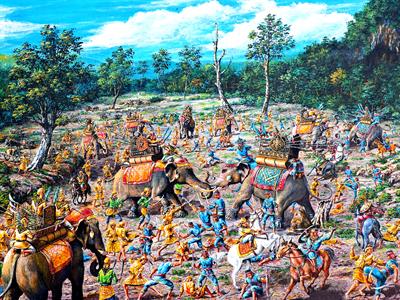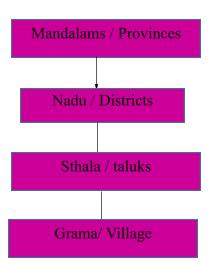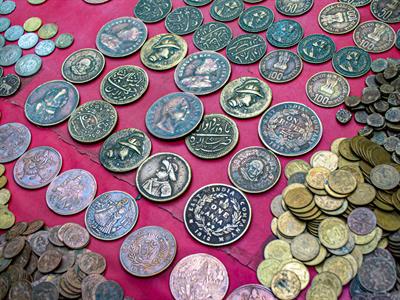PDF chapter test TRY NOW
The Battle of Talikota / Rakasa Tangadi (1565):
- The Vijayanagar empire faced strains Post the demise of Krishna Devaraya, who was considered the ablest ruler of the dynasty. The Successors of Devaraya like Achyuta deva Raya and his other successors were completely incapable of taking the situation under control.

Battle of Talikota
- Sadasiva Raya who was a small child ascended the throne as a nominal head of the dynasty, who was ably supported by his commander Rama Raya who was the real ruler of the state.
- Sensing the situation, the Sultans of Deccan and the like-minded partners allied to topple the Vijayanagar empire which culminated in a full-blown war known as the “Battle of Talikota or Rakasa Tangadi”.

- The Deccan sultans routed the Vijayanagar army, which couldn’t stand the wrath of the combined forces, mass plunder and butchering took place during the war.
GILANI BROTHERS: They were the key commanders of the Vijayanagar empire who betrayed the kingdom during the Battle of Talikota, which led to the defeat of Vijayanagar forces.
- The Battle ended the supremacy of the Tuluva dynasty and brought curtains to the Vijayanagar empire which is no more a powerhouse in South India.
The Aravidu Dynasty: (1570 AD -1646 AD)
- During the Battle of Rakasa Tangadi, sensing the defeat of the Vijayanagar empire Tirumaladeva Raya, brother of Rama Raya carried Sadasiva Raya the child prince and fled the Battleground.
SRI RANGA III: He was the last ruler of the Vijayanagar empire as his rule witnessed the complete disintegration and end of the mighty empire.
- He shifted his base to Penugonda and then to Chandragiri and made its capital and established the Aravidu Dynasty. Internal rivalry among the small rulers led to the downfall of the dynasty and put an end to the Mighty Vijayanagar empire.
The Vijayanagar administration:
- The administration of Vijayanagar followed a model of Proper hierarchy where the position of king is mostly Hereditary but was also seen as flexible at that time as the king allowed peaceful transmission of power to his successor.
- The case of usurping to power was also seen in some instances like how the Sangama dynasty came into existence by toppling the Predecessor by Saluva Narasimha who was the Commander of the forces.
- There are cases of real and nominal rulers during the latter part of the Vijayanagar Administration.
Provincial Setup of Vijayanagar
- The rulers of the Vijayanagar empire separated the large provinces into small sectors for their administrative convenience. The administrative units of the Kingdoms are given below.

- The Mandalam is the largest of the administrative units which were headed by “Mandaleshvar” and the Villages are at the bottom of the administrative setup which had Gram Sabha which was headed by “Gauda”.
- The Rulers gave complete autonomy to the local bodies as they didn’t interfere in their affairs.
Army
- The empire had a strong army empowered with Cavalry and armed persons with horses and enhanced artillery which was not seen among the contemporaries of the Vijayanagar Kingdom.
- Trade relationship with the Portuguese brought them advanced fighting equipment which enabled the empire to defend its territories.
The State of Vijayanagar economy:

Coins of Vijayanagar Empire
- The Vijayanagar empire was flourishing among its contemporaries around the world. It had economic ties with foreign powers which were mentioned in various foreign accounts by travellers visiting the countries.
BARBOSA: He is a Portuguese trade merchant who gave a valuable account regarding the government of Vijayanagar.
- Various diamond mining areas were located in areas of Kurnool and Anantpur. It was also supported by the shipbuilding industry which enhanced the exports of the empire.
- The rulers of the empire also issued numerous gold coins namely “Varahans”. Land revenue was an important source of income for the kingdom. 1/6th of the produce was collected as revenue by the state.
